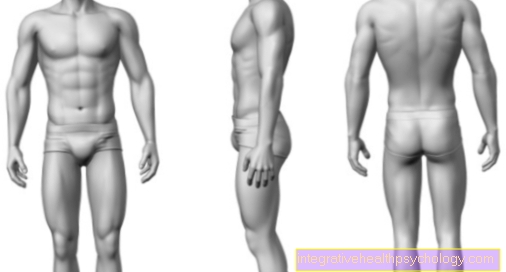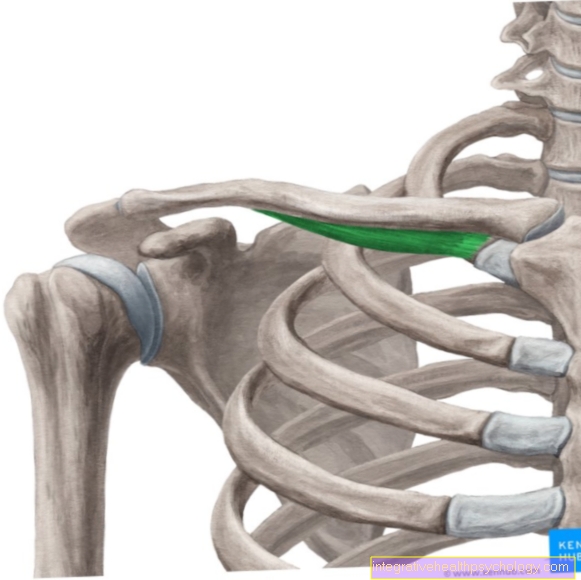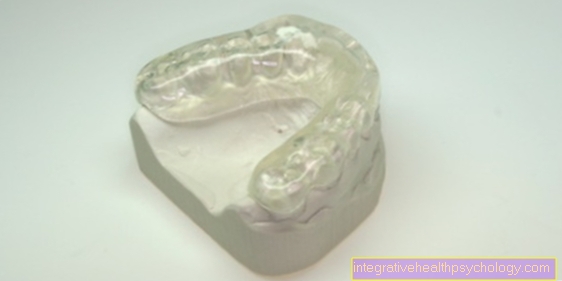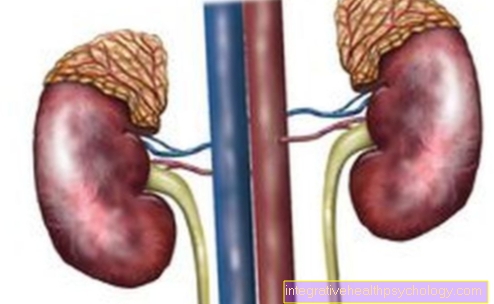Transferrin
definition
Transferrin is a protein that plays an important role in the metabolism of iron. The iron reaches the intestine with food, from where it is transported to the intestinal wall cells via certain transporters. From there the iron has to get into the blood. Since high iron concentrations in the blood are poisonous, iron needs a transport protein, which is transferrin. Without iron, the protein is called apotransferrin from a biochemical point of view. Once the apotransferrin has bound its iron, it becomes transferrin.

What is transferrin saturation?
Transferrin saturation describes the proportion of transferrin that is loaded with iron. Most of the transferrin in the form of its precursor (apotransferrin) floats around freely in the blood.
Only when it binds the iron does it nominally become transferrin. The proportion of transferrin that is loaded with iron is normally around 20 to 30%, but is not yet pathologically increased up to 50%. Transferrin saturation can be calculated from the amount of transferrin and the concentration of iron in the blood.
When is transferrin determined in the blood?
Transferrin gives a good overview of the iron metabolism in the body.
If the transferrin is in the normal range, the body has usually absorbed a balanced amount of iron. Information about the state of the iron metabolism can also be collected via transferrin saturation.
If the transferrin is increased, however, this is often an indication that the body has too little iron. The body tries to absorb more iron from the intestinal cells by increasing the transferrin.
Signs of an iron deficiency can be increased tiredness, poor performance, headaches and difficulty concentrating. As part of the clarification of iron deficiency and the resulting anemia (anemia), a determination of the transferrin can also be useful.
Do you suspect iron deficiency is the cause of your problems? - Then read our article: Symptoms of iron deficiency
In contrast, symptoms that indicate a lack of transferrin can also occur. In this case, there is usually an iron overload, as is the case, for example, with iron storage diseases (hemochromatosis).
Do you suspect iron storage disease is the cause of your problems? - Then read our article: Symptoms of hemochromatosis
By consuming too much iron, the body tries to avoid further iron by making only a few transport proteins available. In the case of suspected iron storage diseases, the determination of the transferrin value can therefore be useful.
Transferrin is also considered an anti-acute phase protein, as it is often lowered in inflammation and infection in the body. Although transferrin is not one of the classic laboratory parameters that are determined when an inflammation is suspected, a decrease in transferrin in the blood can occasionally be useful and provide valuable information about the origin of the infection.
How is transferrin in the blood determined?
Since transferrin is normally in the blood, the transferrin value can be determined by a normal laboratory test of the blood.
To do this, a blood sample is taken, in which a vein is pierced with a needle, then around five milliliters of blood are poured into a tube. This can then be sent to the laboratory, where various values are determined.
It usually makes sense to determine other values that play a role in iron metabolism in addition to transferrin. On the one hand, you should determine the amount of iron in the serum. In this way one can draw conclusions about the transferrin saturation. The determination of the hemoglobin value, the erythrocyte count and the ferritin value can also be useful. Many clinical pictures result from the overall picture of these blood values.
Would you like to read more about these laboratory values? - Then read our articles about:
- hemoglobin
- Ferritin
Evaluation of transferrin values
The evaluation of the determination of transferrin is based on the standard values.
A transferrin value above 400 mg / dl is an increased transferrin value. The transferrin is reduced from a value below 200 mg / dl.
In connection with transferrin saturation (which should be between 20 and 50%), there may be indications of iron deficiency diseases or iron storage diseases with too much iron intake.
There are also two other forms of transferrin. The beta-2-transferrin can be determined, for example, in the liquor (cerebral fluid) and indicates traces of blood that are caused, for example, by a fracture of the skull base.
Another version of transferrin (carbohydrate-deficient transferrin) can be an indicator of chronic alcoholism.
Causes for a too low transferrin value
There are numerous causes for a lowered transferrin level. Depending on the underlying disease, more extensive diagnostics should be carried out if there is a transferrin deficiency.
The concentration of transferrin in the blood is usually related to iron, so that the entire iron metabolic pathway should be looked at. There are many harmless causes of transferrin deficiency.
As an anti-acute phase protein, the transferrin value decreases in inflammation. A low transferrin can therefore be triggered by colds, infections or the flu.
Autoimmune diseases are also associated with inflammation in the body, so that they can lower the transferrin level.
If many erythrocytes (red blood cells) are destroyed, iron is released into the blood. This is bound by transferrin, which is why a high transferrin saturation is usually noticeable as a result. In addition, the body lowers the production of transferrin so that more iron is not absorbed.
Causes of low transferrin levels that require clarification are liver diseases or iron storage diseases. These values initially drive up the ferritin value and subsequently lead to a lower transferrin.
A release of ferritin is caused, for example, by damage to liver cells. The ferritin is stored in the liver cells and escapes into the blood when damaged. Then there is a reactive decrease in transferrin.
Causes for a transferrin level that is too high
There are many reasons why transferrin levels can rise. Usually a pronounced iron deficiency is the origin of the change. The reason for this is usually an insufficient iron intake.
In response, the body increases the production of transferrin so that more iron can be absorbed from the intestines and bound in the blood. Alternatively, an increased iron requirement or blood loss and thus also the loss of iron are the reasons for the increased reactive production of transferrin.
In pregnant women, endurance athletes and children or adolescents, the iron deficiency can also be due to an increased need. During pregnancy, a three-fold higher concentration of iron is often required, while breastfeeding only requires twice as much iron.
Read our article about: Iron Deficiency During Pregnancy
Endurance athletes train their bodies to transport oxygen particularly effectively. Since a lot of iron is required for this, the iron requirement also increases with increasing training in these athletes.
Children and adolescents usually do not have an exceptionally high need for iron, but in strong growth phases a particularly high amount of iron can suddenly be required for a short time.
The loss of iron is usually associated with blood loss. Bleeding in the gastrointestinal tract is often the cause, but other chronic bleeding or sudden heavy blood loss in accidents or major operations can also be the cause of iron loss. The body tries to compensate for this with increased transferrin values.
In general, women are more often affected by high levels of transferrin. This is due to the physiological (natural) regular menstrual bleeding, in which also not negligible amounts of blood and iron are lost.
What can you do if the transferrin values are changed?
Changes in transferrin values should usually have therapeutic consequences. The transferrin usually only changes when there has been an imbalance in the iron metabolism for a long time.
Changes in transferrin values are therefore an indication of an iron problem that the body cannot regulate by itself.
If the transferrin level is elevated, it is assumed that there is a deficiency in iron, so the supply of iron is essential for the therapy of the decreased transferrin. This can often be achieved simply by increasing the iron intake with the food by increasing the consumption of foods such as legumes, meat, oatmeal and nuts. If this is not enough, iron tablets can be given over a period of several months.
Read everything about the under the following link Diet for iron deficiency
It is often particularly helpful to also check the vitamin balance, as some vitamins play an important role in iron absorption.
A low transferrin value, on the other hand, is often a sign that the body is overloaded with iron. A detailed diagnosis should first be carried out here, as the causes are not always harmless.
Many of the underlying diseases, such as hemochromatosis, can be treated well in the early stages, but if you discover them too late, permanent organ damage can result.
Transferrin determination costs
The costs for a transferrin determination cannot be precisely quantified. This is particularly due to the fact that transferrin is rarely determined on its own.
Instead, the transferrin is determined as part of the clarification of the entire iron metabolic pathway. Iron, hemoglobin, erythrocyte count and ferritin are usually determined at the same time.
In order to calculate the isolated costs for the transferrin determination, one would also have to calculate the costs for the blood collection and the sending of the blood sample. As a rule, the cost of determining the transferrin is covered by the health insurance company.
What is the transferrin receptor?
There are two different types of transferrin receptors (TfR).
The TfR 1 is formed by all body cells, the TfR 2, on the other hand, is almost only found in the liver.
The transferrin receptors are used by the respective cells to absorb iron. The iron-loaded transferrin is bound to the receptor. This triggers a mechanism in the cell in which the iron is released from the transferrin and channeled into the cell. The transferrin is then emptied again and can absorb new iron.





























